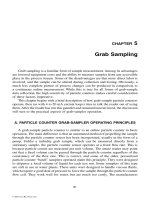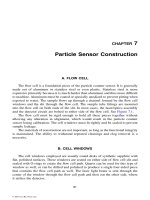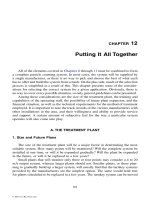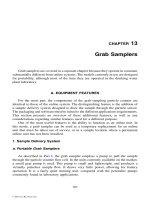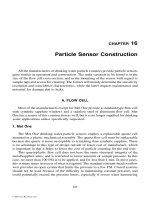GIS for Coastal Zone Management - Chapter 16 potx
Bạn đang xem bản rút gọn của tài liệu. Xem và tải ngay bản đầy đủ của tài liệu tại đây (221.85 KB, 9 trang )
CHAPTER SIXTEEN
Mapping and Analysing Historical
Shoreline Changes Using GIS
Courtney A. Schupp, E. Robert Thieler and James F. O’Connell
16.1 INTRODUCTION
Understanding coastal change has become increasingly important to the 78 coastal
communities in Massachusetts. About half of Massachusetts’ 6.2 million residents
now live in the coastal zone, and the coastal population is growing rapidly.
Erosion threatens beachfront houses and development along much of the state’s
2400 km of shoreline, creating a critical need for the government and the public to
have accurate, up-to-date information on shoreline change. Prior to this shoreline
change update, however, Massachusetts’ existing historical shoreline change
database had not been updated since 1978. New maps and data displaying long-
term and more recent trends of shoreline behaviour increase the capability for
sound decision-making and enhance public awareness of coastal change in
Massachusetts.
To produce the necessary maps and data, we compiled historical shoreline
positions in ArcInfo from a variety of map and aerial photograph sources. We
generated 1:10,000 scale maps of the Massachusetts coast that display historical
shorelines, rates of change, locations of rate-of-change measurements (transects),
and orthophotographs. We also enhanced a Microsoft Access database created by
Van Dusen (1996) that contains transects, dates, and rates of change; it can be used
to perform spatial queries and to compile regional statistics and trends. The
Massachusetts Office of Coastal Zone Management (MCZM) will distribute these
maps, along with the data tables and a manual describing how to use the
information, to regional government offices and coastal communities. These
products will also be made available to the public through the Internet.
© 2005 by CRC Press LLC
16.2 METHODS
16.2.1 Data Sources
Previous projects digitised and assembled historical shoreline data for the
Massachusetts coast from 1842 to 1978 into ArcView GIS format (Benoit, 1989;
O’Connell, 1997). Those projects obtained shorelines from six different data
sources: 1) National Ocean Service (NOS) topographic maps (T-sheets), 2) NOS
hydrographic maps (H-sheets), 3) Federal Emergency Management Agency
(FEMA) Flood Insurance Study topographic maps, 4) printed orthophotographs, 5)
aerial photographs, and 6) digital orthophotographs. The early shorelines (1842 to
1950) were digitised exclusively from NOS T- and H-sheets. Shorelines from the
1970s were compiled by digitising FEMA topographic maps, printed
orthophotographs, and aerial photographs. These early data sets were digitised and
placed into a GIS-compatible format using the Metric Mapping System (Clow and
Leatherman, 1984; Benoit, 1989).
The aerial photography used to generate the 1994 orthophotographs has a
nominal scale of 1:48,000 and was taken by the National Ocean Service in
September and October of 1994. MCZM provided full-colour digital mosaicked
orthophotographs that have a resolution of one meter per pixel. We used these
geographically registered orthophotographs to digitise the 1994 shoreline directly
within ArcView GIS software.
There are several possibilities for identifying a high-water shoreline. In most
locations, we delineated the shoreline using the high-tide wrack line. However,
due to the range in geomorphology along the Massachusetts coast, other
delineations were sometimes more appropriate, such as the wet/dry interface, algal
lines along rocky shores, vegetation changes in salt marshes, and the interface
between seawalls and open water. Photographs of some areas, such as bleached-
out sandy beaches, were difficult to interpret visually. In these cases, field checks
and historical shorelines aided interpretation of the orthophotographs.
To verify the accuracy of orthophotograph rectification, we selected control
points along the Massachusetts shore at easily recognizable sites, such as building
corners and street intersections. We located these sites in the field and recorded
the DGPS coordinates, which we then compared to orthophotograph coordinates.
Results show that the orthophotographs comply with National Map Accuracy
Standards (U.S. Bureau of the Budget, 1947).
Due to the variety of aerial photograph data sources and analytical
techniques used to compile the shoreline positions described here, there are a
number of potential sources of error that affect the accuracy of the shoreline
positions shown on the shoreline change maps. Since much of the historical
database had not been checked previously for geographic accuracy, the historical
database was subjected to quality control review. The relatively high geographic
accuracy and photographic detail of the 1994 orthophotographs, as evidenced by
the accurate display of roads, buildings, and shoreline structures, allowed the
identification of errors in the pre-1994 shorelines. Although the pre-existing data
set was represented to comply with National Map Accuracy Standards, there are
inevitably errors in any large spatial data set that more accurate data bring to light.
© 2005 by CRC Press LLC
Our analysis resulted in the removal of approximately 43 kilometres of poor-
quality data that could have contributed to erroneous interpretations of shoreline
change.
Analysis of the various sources of error suggests that the individual shoreline
positions in our completed data set are generally accurate to within +/- 8.5 meters.
Rates of shoreline change derived from these shorelines have a resolution of +/-
0.12 meters/year (Thieler et al., 2001).
16.2.2 Generating the 1994 Shoreline
We used the line tool in ArcView 3.2 to delineate shoreline segments for each
orthophotograph at a scale of >= 1:2,000. After saving shapefiles of the 1994
shoreline segments for each orthophotograph, we used the ArcView
Geoprocessing Wizard extension to merge all segments into a single shapefile
containing the 1994 shoreline. We added the attributes “length” and “year” to the
attribute table before using the Geoprocessing Wizard again to merge the 1994
shoreline with the shapefile of historical shorelines.
Some areas had highly migratory shorelines, such as barrier islands where
the landward migration over the past 150 years exceeded the width of the island.
To ensure that seaward shorelines would only be compared to other seaward
shorelines, and not to any landward shorelines, it was necessary to create two
edited versions of the shoreline coverages. One coverage included only the
seaward edge of migrating areas (for example, only the open-ocean side of a
barrier island); the complementary coverage included only landward coasts (for
example, only the bay side of a barrier island). This method enabled us to examine
barrier island migration in addition to shoreline change.
16.2.3 Preparing the Workspaces
We used a suite of Arc Macro Language (AML) programs and a modified version
of programs in the Digital Shoreline Analysis System (DSAS; Danforth and
Thieler, 1992; Thieler and Danforth, 1994; Van Dusen, 1996) to pinpoint shoreline
positions, cast orthogonal transects along the shoreline, compute a linear
regression of the rate of shoreline change at each transect location, collect all of
the rates and statistics into an INFO database, and create 1:10,000 scale maps. To
achieve this it was necessary to establish a shore-parallel baseline and to create
sequentially numbered workspaces containing data for each coastal area.
To establish a point of reference for shoreline change measurement, we used
the
buffer command to draw baseline segments 50 meters landward of and parallel
to the general trend of the shorelines. We used a combination of the ArcEdit
commands
unsplit, grain, and spline to modify the baseline, placing vertices at 20
meter intervals. Van Dusen (1996) described a similar approach using the
spline,
generalize
, and densify commands.
We saved each baseline segment, typically about 7 kilometres long, in its
own workspace along with a coverage containing the corresponding shorelines.
Using polygon coverages, we clipped the larger shoreline coverages, thereby
creating smaller coverages to reduce AML processing time.
© 2005 by CRC Press LLC
Once all of the completed shoreline and baseline coverages were saved in the
appropriate workspaces, we ran an AML to format the data for the transect-casting
and rate calculation software. In each workspace, the AML created a frequency
file listing of all of the shoreline years in that area. The AML then used this file
with the
reselect command to select arcs by their year attribute before using the
build and ungenerate commands on the coverage. It also used the frequency file to
create a file containing the date for each shoreline. It created formatted text files
for the baseline and all shorelines using the generate files.
16.2.4 Digital Shoreline Analysis System
As described by Van Dusen (1996), the basic software used to determine shoreline
rates-of-change was a modified version of the DSAS, developed by the U.S.
Geological Survey (Danforth and Thieler, 1992). This software is comprised of
two C programs. Using the formatted text files, the first program applied a
baseline-vertex approach to cast orthogonal transects from each vertex on the
baseline to the most seaward shoreline (Figure 16.1 and colour insert following
page 169). The program also created a file that contained both the coordinates of
points at which the transects crossed each shoreline, and the dates associated with
each of those shoreline points. A second C program used this file to compute the
rates of change between shorelines at each transect location and to collect all of the
rates and statistics into an INFO database. The resulting output file includes four
statistical measurements for each transect: the end point rate, average of rates,
linear regression rate, and jackknife rate.
These rates of shoreline change (Dolan et al., 1991) were calculated by
measuring the differences between shoreline positions through time along a given
transect. The end point rate was calculated by dividing the distance of shoreline
movement by the time elapsed between the oldest and the most recent shoreline.
The average of rates method (Foster and Savage, 1989) involved calculating
separate end point rates for all combinations of shorelines and then taking the
average of all end point rates. A linear regression rate-of-change statistic
was determined by fitting a least squares regression line to all shoreline points for
a particular transect; the rate is the slope of the line. The jackknife rate was
implemented as an iterative linear regression which calculates a linear regression
fit to shoreline data points with all possible combinations of shoreline points,
leaving out one point in each iteration. The slopes of the linear regression lines
were averaged to yield the jackknife rate.
16.2.5 Compiling the Data
A suite of four AMLs formatted the output files from the two C programs for the
maps and database. The first AML created a coverage of the transect lines with
associated shoreline change rates. To do this, it built the transect coverage as lines
with the
build command and added formatting symbols and values for the baseline
and transect numbers to the attribute table for use in labelling transects on the
maps. In order to determine angle and direction of the lines, it then built line and
node topology and added coordinates of the transect nodes to the coverage’s node
© 2005 by CRC Press LLC
attribute table. Next, it imported the data from files created by the rate-calculation
program into the ArcInfo tables and established a relate in the workspace for the
next step. After joining the area files to the transect attribute table for that area,
the AML brought the related information and arcs to a new appended coverage.
At this point, all of the necessary map coordinates and rate-of-change
statistics were calculated. A second AML made a database for export to Microsoft
Access. This AML employed the
append command to create a new coverage
containing the transects for the area workspaces. It then used the
tics option with
the
append command to renumber transects in the appended coverage with unique,
sequential ID values. After building the line coverage, the AML added a new item
to the attribute table to allow reselection of every other transect. It then deleted
alternate transects, creating a 40 meter interval for display on the printed maps,
and renumbered the transects for labelling in the database and on maps. It also
utilized the
additem and join commands to add the town names from a separate
coverage to the transect coverage. The final routine sorted the transect coverage
by baseline and transect numbers.
We used ArcMap to remove manually the poorly located transects that
crossed inlets and jetties. After the manual edits, a third AML added items to the
attribute table of the transect coverage and selected the attribute table in
ArcTables. It used the ArcEdit
command
unsplit to combine the identification arcs
in the transect coverage and then built the transect line coverage. The AML then
sorted the transects by transect number in ArcTables. After using the
copyinfo
command on the transect attribute table to create a data file, the AML used
dropitem to delete attributes such as TNODE that are unnecessary for a user
database. It then sorted this data file by transect number and used the
infodbase
command to create a database file. A final AML created the last files needed for
the database by indexing the transects according to which map would display
them. Using the
infofile command, it created a DAT file for each map containing
the transect number, town name, and town identification number. Finally, it used
the
infodbase command to copy this information into DBASE III+ files.
We imported the INFO database into Microsoft Access and converted it to a
standalone application to improve users’ ability to perform spatial queries and to
compile regional statistics and trends. The database forms, reports, and macros
were set up for an interactive display; only the tables needed to be replaced with
the new database files and the transect coverage database. We used a macro to
update the database with the new statistics and to calculate mean rates and
bounding shoreline dates for each transect.
© 2005 by CRC Press LLC
Figure 16.1 The transect casting scheme used to determine locations for the measurement of
shoreline rates of change.
16.2.6 Map Production
The final project goal was to generate maps displaying shoreline change. We used
an AML to format the maps with a legend and other explanatory information. This
AML used the
reselect command to draw shorelines with a different colour for
each era. It also used the command
relate add to correlate the files created by the
rate-calculation program to the existing relate environment, which was saved as an
INFO file. The
readselect command selected every other transect in the writefile
of selected transects, and the ArcPlot commands
arcendtext and leadertolerance
allowed the transects to be labelled with the associated identification number and
linear regression rate of change.
16.3 RESULTS
The series of programs described above produced an Access database that can be
searched by map number, community name, or transect number. Transect statistics
can be listed in a table or graphed in histograms. The tables and histograms can
either be printed or viewed on screen (Figure 16.2 and Figure 16.3).
© 2005 by CRC Press LLC
Figure 16.2 Sample histogram depicting interim rates of change.
Figure 16.3 Sample transect listing produced by the Access database.
The programs also produced 91 ArcPlot files. The area maps of the
Massachusetts coast are at a scale of 1:10,000 and display historical shorelines,
transect locations, and long-term rates of change overlaid on the 1994
orthophotographs (shown in Colour Plate 16.1, following page 164).
The resulting database and maps include a total of 30,354 transects spaced at
40 meters along the coast of Massachusetts. Linear regression rates indicate
erosion at 68% of the transects, accretion at 30% of the transects, and no net
change at 2% of the transect locations.
Both the highest and lowest linear regression rates, 15.2 meters per year of
accretion and 12.9 meters per year of erosion, occur on Nauset Beach in Chatham,
where the barrier island shoreline faces the open Atlantic Ocean.
Several coastal areas have nearly the same number of accreting areas as
eroding areas, such as Hingham (47% eroding, 48% accreting) and Hull (50%
eroding, 46% accreting). Both of these areas are located within 40 kilometres of
Boston, are highly populated, and have a number of seawalls holding the shoreline
in place.
© 2005 by CRC Press LLC
Eroding transect locations predominate in Plum Island (74% eroding, 24%
accreting), Truro (83% eroding, 15% accreting), Wellfleet (81% eroding, 18%
accreting), and Barnstable (73% eroding, 25% accreting). All of these areas have
exposed sandy beaches.
The number of accreting transect locations exceeds the number of eroding
transect locations in Harwich (36% eroding, 63% accreting), which is shielded by
Monomoy Island to the southeast, and Manchester (40% eroding, 53% accreting),
which is characterized by rocky cliffs interspersed with stretches of sandy beaches.
The maps and database serve many purposes and interests. For example, state and
local government agencies use the historical rate-of-change data to manage and
regulate coastal development. Developers and potential homebuyers can examine
the maps to determine the stability of beachfront property. Residents can view
post-storm erosion in the context of long-term shoreline variability. This
information can also aid in evaluating past management efforts, such as the
emplacement of seawalls, jetties, and groins that have influenced shoreline change.
MCZM distributes these maps, along with the database and a manual
describing how to use the information, to regional government offices and coastal
communities. These products will also be made available to the public on the
Internet.
16.4 SUMMARY
This project addresses the increasing need to measure and document coastal
change by combining established shoreline evaluation techniques with improved
GIS applications. The resulting maps and database comprise a current and
accessible source of information on coastal change in Massachusetts, including
historical shorelines and shoreline change statistics. Coastal managers in
Massachusetts can continue to benefit from the database by updating the database
with new shorelines and rerunning the suite of AMLs and C programs that
calculate change and produce maps.
Academics, consultants, citizen groups, developers, and government agencies
can use the map and data products described in this paper for a variety of purposes
and interests. The database and maps have the potential to improve decisions
concerning coastal management, residential and commercial development, and
coastal research by making shoreline data comprehensible and available to a wide
audience. The maps displaying shorelines and rates of change are visually
appealing and quickly understood, particularly when overlaid on
orthophotographs. More detailed information is readily available in an interactive
database. If further modifications are desired, new modules can be incorporated
into the current program and database structure. These methods and products are
an excellent resource for anyone interested in coastal change, and they serve as a
solid foundation for future applications.
16.5 ACKNOWLEDGEMENTS
The Massachusetts Shoreline Change Project was funded by the Massachusetts
Office of Coastal Zone Management pursuant to a grant from the National Oceanic
© 2005 by CRC Press LLC
and Atmospheric Administration, Award NA970Z0165. Susan Snow-Cotter,
Steve Mague, Diane Carle, and Rebecca Haney of CZM offered many valuable
suggestions for the development of the maps and users guide. Bill Danforth of the
USGS provided computer support. Technical reviews by Laura Moore and Larry
Poppe improved the clarity and content of the paper.
16.6 REFERENCES
Benoit, J. R., ed., 1989,
Massachusetts Shoreline Change Project. (Boston:
Massachusetts Office of Coastal Zone Management), pp. 19, appendices.
Clow, J.B., and Leatherman, S.P., 1984, Metric mapping: An automated technique
of shoreline mapping. In
Proceedings, 44th American Congress on Surveying
and Mapping
, American Society of Photogrammetry, pp. 309-318.
Danforth, W.W., and Thieler, E.R., 1992, Digital Shoreline Analysis System
(DSAS) User's Guide, Version 1.0.
U.S. Geological Survey Open-File Report
No. 92-355
. (Reston, Virginia: U.S. Geological Survey), pp. 42.
Dolan, R., Fenster, M.S., and Holme, S.J., 1991, Temporal analysis of shoreline
recession and accretion.
Journal of Coastal Research, 7 (3), pp. 723-744.
Foster, E.R., and Savage, R.J., 1989, Methods of historical shoreline analysis. In
Coastal Zone '89, Proceedings of the Sixth Symposium on Coastal and Ocean
Management
. (New York: ASCE), pp. 4420-4433.
O’Connell, J.F., 1997, Historic shoreline change mapping and analysis along the
Massachusetts shore. In
Coastal Zone ’97, Proceedings of the Tenth Symposium
on Coastal and Ocean Management
. (New York: ASCE).
Thieler, E.R. and Danforth, W.W., 1994, Historical shoreline mapping (II):
application of the Digital Shoreline Mapping and Analysis Systems
(DSMS/DSAS) to shoreline change mapping in Puerto Rico.
Journal of Coastal
Research
, 10, pp. 600-620.
Thieler, E.R., O’Connell, J.F., and Schupp, C.A., 2001,
The Massachusetts
Shoreline Change Project: Technical Report 1800s to 1994.
U.S. Geological
Survey Administrative Report. (Woods Hole, Massachusetts: U.S. Geological
Survey), pp. 36.
U.S. Bureau of the Budget, 1947, National Map Accuracy Standards.
(Washington: U.S. Government Printing Office).
Van Dusen, C., 1996,
Vector based shoreline analysis. Unpublished report.
(Boston: Applied Geographics, Inc.).
© 2005 by CRC Press LLC



